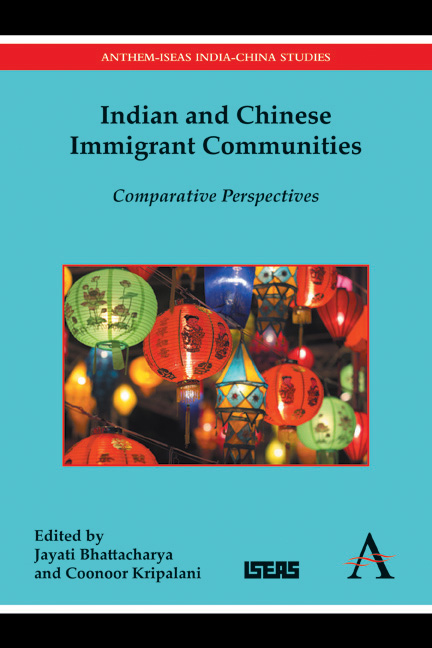Book contents
- Frontmatter
- Contents
- Foreword
- Acknowledgements
- Introduction
- Section I Historical Antecedents and the Question of Nationality
- Section II The Meeting Ground: Indians and Chinese in Southeast Asia
- 4 China's Nationality Laws and the Chinese Overseas
- 5 A Comparison of the Home Remittance Systems of Indian and Chinese Migrants in Southeast Asia: Nineteenth and Twentieth Centuries
- 6 Identity, Transnationalism and Corporate Development: Chinese Business in Malaysia
- 7 Beyond the Glitterati: The Indian and Chinese Jewellers of Little India, Singapore
- 8 Indian and Chinese Communities in Contemporary Burma: A Comparative Analysis of Their Presence and Influence
- 9 Expressions of Faith in Hindu Processional Festivals: Case Studies from Singapore and Malaysia
- 10 Beyond Boundaries? Hindu Spaces in the Chinatowns of Kolkata and Singapore
- Section III Indians in China and Chinese in India
- Section IV Across the Globe: Indian and Chinese Diasporas
- Postscript Shifting Worlds and Changing Identities: The Reshaping of the Chinese-Indian Communities in India after the 1962 “Sino-Indian Incident”
- List of Contributors
- Index
9 - Expressions of Faith in Hindu Processional Festivals: Case Studies from Singapore and Malaysia
from Section II - The Meeting Ground: Indians and Chinese in Southeast Asia
Published online by Cambridge University Press: 05 December 2015
- Frontmatter
- Contents
- Foreword
- Acknowledgements
- Introduction
- Section I Historical Antecedents and the Question of Nationality
- Section II The Meeting Ground: Indians and Chinese in Southeast Asia
- 4 China's Nationality Laws and the Chinese Overseas
- 5 A Comparison of the Home Remittance Systems of Indian and Chinese Migrants in Southeast Asia: Nineteenth and Twentieth Centuries
- 6 Identity, Transnationalism and Corporate Development: Chinese Business in Malaysia
- 7 Beyond the Glitterati: The Indian and Chinese Jewellers of Little India, Singapore
- 8 Indian and Chinese Communities in Contemporary Burma: A Comparative Analysis of Their Presence and Influence
- 9 Expressions of Faith in Hindu Processional Festivals: Case Studies from Singapore and Malaysia
- 10 Beyond Boundaries? Hindu Spaces in the Chinatowns of Kolkata and Singapore
- Section III Indians in China and Chinese in India
- Section IV Across the Globe: Indian and Chinese Diasporas
- Postscript Shifting Worlds and Changing Identities: The Reshaping of the Chinese-Indian Communities in India after the 1962 “Sino-Indian Incident”
- List of Contributors
- Index
Summary
Introduction
Religion and its practice is an expression of diasporic behaviour, and its multicultural relevance at both the social and political levels is truly the best tool to study any community or country with a huge migrant population. In the case of Singapore and Malaysia through the colonial days, their multicultural population historically has demonstrated religious tolerance, which has enabled the Hindu community to practice its religious festivals even to this day. This paper will focus on the survival, evolution and modifications these festivals, and in particular their public expression through festival processions, have undergone compared to how they were practiced in their place of origin in India. Processions are subject to innovations and their purpose can also change. This paper examines the cultural and social aspects of the practice and examines the expression of devotion to Murukan among Indian and Chinese devotees as observed during processions and ritual practices for the celebration of the kavadi festival Thaipusam in Singapore, Malacca and Penang, as well as to Mariamman during Theemithi in Singapore. Thaipusam, celebrated in the month of Thai in the Hindu calendar (occurring January–February in the Gregorian calendar), is a thanksgiving festival dedicated to the Hindu god Murukan involving asceticism and control over ones senses, while Theemithi is a ritual street theatre performance culminating in walking on burning coal.
This study analyses the way piety is expressed among worshippers observing these festivals and what inspires this piety. Many of the practices around Murukan worship are connected to the Indian diaspora that brought ritual worship to British Malaya in the nineteenth century. Many were plantation workers who brought their folk practices from the villages of Tamil Nadu and practised them in Singapore and parts of Malaysia. When and how the expression of faith went beyond the kampong and the Indian fold and started attracting other races, especially the Chinese, requires more in-depth research.
- Type
- Chapter
- Information
- Indian and Chinese Immigrant CommunitiesComparative Perspectives, pp. 137 - 152Publisher: Anthem PressPrint publication year: 2015



